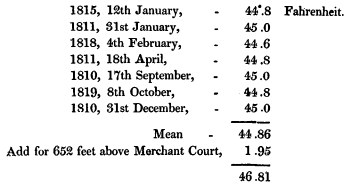Article contents
XIII. Observations on the Mean Temperature of the Globe
Published online by Cambridge University Press: 17 January 2013
Extract
If no provision has been made by the Great Author of Nature, for equalising the light and heat projected upon the different bodies of our system, we may consider the earth as receiving, from the direct action of the solar rays, a degree of heat, intermediate between the condensed radiations sustained by Mercury and Venus, and the attenuated warmth which reaches the remoter planets. The heat which our Globe thus acquires from its locality in the system, is again tempered by the obliquity of its axis, and is distributed over the same parallels of latitude by its daily rotation. When the Sun is in the Equator, his rays, beating on the Earth with a vertical influence, impart to it the full measure of their action; and as his meridian altitude decreases, their intensity suffers a corresponding diminution. The burning heat at the Equator becomes moderated in higher latitudes. In passing through the temperate zone, it declines with great rapidity, and between the Arctic Circle and the Pole, the rays of the Sun are unable even to temper the piercing cold which reigns in these inhospitable regions.
- Type
- Research Article
- Information
- Earth and Environmental Science Transactions of The Royal Society of Edinburgh , Volume 9 , Issue 1 , 1823 , pp. 201 - 225
- Copyright
- Copyright © Royal Society of Edinburgh 1823
References
page 204 note * This Memoir has been translated into English, and published in the Edinburgh Philosophical Journal, vol. iii. and iv.
page 207 note * This interesting investigation is now published, in MrScoresby's, excellent Account of the Arctic Regions, vol. i. p. 356Google Scholar.
page 209 note * As Mr Playfair's observations were made in Windmill Street and Buccleuch Place, where the thermometer must have been influenced by the heat reflected from the opposite sides of these streets, I consider the mean of his annual temperatures, viz. 47°.8, as erring in excess, and have therefore preferred 46°.23, the result of Messrs Miller and Adie's observations.
This opinion respecting the temperature of Edinburgh is strongly confirmed by the following valuable and accurate observations, made and communicated to me by my friend Mr James Jardine.
Temperature of the Crawley Spring, situated 564 feet above the level of the sea.

Temperature of The Black Spring, situated 882 feet above the level of the sea.


page 210 note * These observations were made in Merchant Court, 230 feet above the level of the sea.
page 210 note † Edinburgh Encyclopædia, Art. America, Sect. Climate of America, vol. i. p. 614Google Scholar.
page 212 note * As this reasoning is founded on the assumption that the Pole is the coldest point of the Globe, the results given above will admit of considerable modification, if that supposition shall be found improbable, as will be shewn in the subsequent part of this paper.
page 213 note * This part of the Paper was read before the Royal Society on the 4th December 1820.
page 215 note * The distance D from the Isothermal Pole is in the coldest meridian D = 80° — Lat.; and in the warmest meridian Cos. D = Cos. 10° × Sin. Lat. In all intermediate meridians we have Cos.
, and
Tang, θ = Cos. M. Tang. L, where M is the difference of longitude between the place and the Pole, L the co-latitude of the Isothermal Pole or 10°, and l the colatitude of the place.
page 216 note * The calculation for the Old World is founded on the supposition, that the meridian to which the mean results of Humboldt belong is at right angles to the ccld meridian in 100° West Longitude. The greater number of places, however, from which the mean was taken, are nearer the Asiatic than the American Pole Hence we see the reason why the differences are all positive.
page 217 note * Reduced to the level of the sea by Humboldt's rule.
page 217 note † The mean temperature in 1814 was 78°.25, and in 1816 75°.75. No correction is applied for its elevation above the sea.
page 219 note * If we suppose that the observations in West Greenland, and those about Hudson's Bay and Labrador, are best fitted to give the position of the Pole, it is obvious, that it should be removed a little from the former, and brought nearer the latter, so as to be placed a degree or so farther South. This change would also produce a greater coincidence with Captain Parry's observations.
page 219 note † For 1779–80. See Phil. Trans.
page 219 note ‡ For 1779–80. See Phil Trans.
page 220 note * Edinburgh Philosophical Journal, vol. iii. p. 263Google Scholar.
page 221 note * See also, vol. I. p. 75.
- 3
- Cited by




